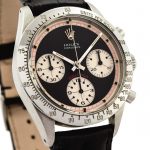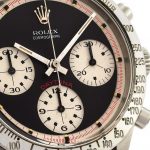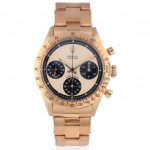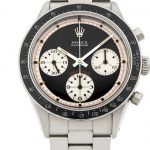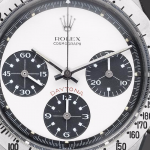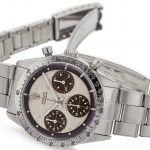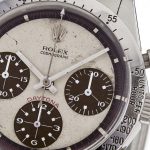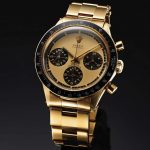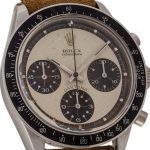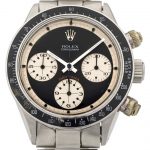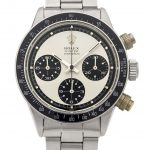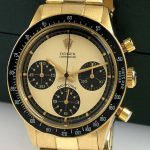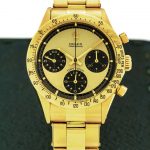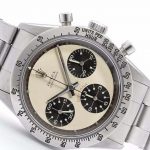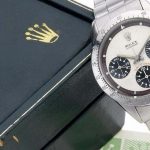Rolex: il quadrante del Daytona Paul Newman[:en]Rolex: the Paul Newman Daytona Dial
BELLO E, QUASI, IMPOSSIBILE. IL MITO DEL QUADRANTE CHE TRASFORMO’ IL ROLEX DAYTONA NEL ROLEX PAUL NEWMAN. NATO ALLA META’ DEGLI ANNI SESSANTA, RICEVETTE IL NOME CON CUI OGGI E’ CONOSCIUTO PROPRIO DAGLI APPASSIONATI ITALIANI. UNA GUIDA RAGIONATA TRA TUTTE LE VERSIONI E I DETTAGLI PER RICONOSCERE UN ORIGINALE DA UN FALSO.
La famiglia dei Rolex Daytona, una genealogia iniziata, secondo la maggior parte della cultura Rolex, con la Ref. 6238 (il “Pre-Daytona”), continua a produrre, senza sosta, un caso di mercato (e di collezionismo) dopo l’altro.
All’interno della numerosa famiglia del modello più famoso e desiderato al mondo del brand, la domanda è scontata: qual è il più prezioso e desiderato di tutti? Risultati d’asta e compravendite tra privati alla mano, la risposta è semplice: parliamo della versione “Paul Newman”, nata negli Anni 60 con il prezioso – e inconsapevole – aiuto dell’indimenticato attore americano dagli occhi di ghiaccio.
Il vero successo planetario di questa versione di quadrante, che trasformò un “semplice” Daytona in un “Paul Newman”, iniziò, come spesso accade, quasi per caso, una volta che fu messo fuori catalogo per cedere il passo al moderno Daytona con movimento automatico. Dal 1980, infatti, per il Paul Newman iniziò una nuova primavera sul mercato collezionistico, con una forte crescita della domanda unita alla diffusione di falsi.
IL QUADRANTE PAUL NEWMAN
Il quadrante Paul Newman, la cui carriera durò circa otto anni, fu montato per la prima volta sul Daytona Ref. 6239 tra il 1965 e il ’66. Quando questa referenza fu lanciata, venne accolta dal mercato con scarso successo. I negozianti facevano non poca fatica a proporla e venderla ai propri clienti tanto da essere una delle poche referenze Rolex venduta con uno sconto d’acquisto.
La conquista dell’altisonante soprannome Paul Newman si deve alla passione dei collezionisti italiani. Questi vi sostituirono i precedenti vezzeggiativi “esotico” e “tropicale” nel 1969, quando questo modello fu notato al polso dell’attore Paul Newman che lo indossava nella locandina del film “Indianapolis pista infernale”.
Successivamente il quadrante Paul Newman venne montato su tutte le referenze Daytona a carica manuale (6239, 6240, 6241, 6262/64, 6263 e la 6265) tranne i modelli in oro delle Ref. 6269 e 6270.
LE CARATTERISTICHE DEL QUADRANTE
QUADRANTE PRINCIPALE
Il quadrante, dall’effetto “granulato” e satinato, offre una grafica bicromatica a contrasto tra quadrante e piccoli contatori (bianco/nero o nero/bianco). Presenta, inoltre, un dislivello tra la parte centrale e i contatori cronografici lavorati a cerchi concentrici. Questo doppio livello contribuisce a creare un quasi impercettibile “gradino” rispetto al centro del quadrante stesso.
Le versioni sono a due o tre colori:
1) fondo bianco Crema con contatori neri e pista dei secondi cronografici nera (chiamato anche Panda dial)
2) fondo chiaro (e contatori neri) o nero (contatori chiari) e scala dei secondi rossa. Quest’ultima configurazione con tre colori è stata prodotta solo sui modelli con cassa in acciaio.
I CONTATORI SECONDARI E LE SCRITTE
Rispetto ai contatori solitamente impiegati sul Daytona normale, quelli del Paul Newman presentano numeri arabi e, come indici, piccoli quadratini applicati e sfaccettati in metallo lucido sui quali è presente, tranne che a ore 12, un pallino di trizio. A ore 6 vi è la anche la scritta T SWISS T mentre a ore 12 sono posizionate corona Rolex, logotipo Rolex e logotipo Cosmograph.
La scritta Daytona, presente unicamente sugli esemplari con pulsanti crono a pompa (Ref. 6239, 6241, 6262 e 6264), è visibile sopra il contatore delle ore cronografiche al 6. Essa è stampata in rosso sui modelli in acciaio mentre sui modelli in oro è stampata in una tonalità di colore in contrasto con il fondo del quadrante. Sui modelli con pulsanti crono a vite (6240, 6263 e 6265) con quadrante bianco, la dicitura Daytona non è presente (vi è solo la scritta Rolex Oyster Cosmograph).
Fonte: www.mazzariolstefanolibrary.com
Photo credit: www.bonhams.com, www.antiquorum.swiss[:en]
WONDERFUL AND, ALMOST, IMPOSSIBLE. THE DIAL MYTH WHICH HAS TRANSFORMED THE ROLEX DAYTONA IN THE ROLEX PAUL NEWMAN. BORN IN THE MID-SIXTIES, IT RECEIVED THE NAME WHEREBY TODAY ITALIAN EXPERTS KNOW IT. A REASONED GUIDE AMONG ALL VERSIONS AND DETAILS TO DISTINGUISH AN ORIGINAL WATCH FROM A COUNTERFEIT ONE.
The Rolex Daytona family, a genealogy which started with the Ref. 6238 (the “Pre-Daytona”) according to most of Rolex culture, continues tirelessly to produce market (and collecting) specimens.
Within the numerous family of the most famous and desired model in the world, the question is taken for granted: what is the most precious and desired one? According to the auction results and private trades, the answer is simple: it is the “Paul Newman” version, born in the ‘60s with the precious – and unknowing – help of the unforgettable American ice-blue eyes actor.
The real planetary success of that dial version which has transformed a “simple” Daytona in the “Paul Newman” one started, as it so often happens, almost by accident, once it was put out of the catalog to be replaced by the modern Daytona with automatic movement. Since 1980, the Paul Newman started a new spring on the collecting market, with a strong growth in demand coupled with the spread of fake.
THE PAUL NEWMAN DIAL
The Paul Newman dial, whose career lasted about eight years, was mounted for the first time on the Daytona Ref. 6239 in 1965-1966. When that reference was launched, it was accepted by market with little success. The shopkeepers struggled to propose and sell it so as to be one of the few Rolex references sold at a discount.
The conquest of the sophisticated Paul Newman nickname is due to the Italian collectors’ passion. They replaced the former “exotic” and “tropical” nicknames in 1969, when that model was noticed on the Paul Newman’s wrist who wore it in the movie poster “Winning”.
Subsequently, the Paul Newman dial was mounted on all hand winding Daytona references (6239, 6240, 6241, 6262/64, 6263 and 6265) except the golden models of Ref. 6269 and 6270.
THE FEATURES OF THE DIAL
MAIN DIAL
The “granular” and satin dial offers a contrasting bicolour graphic between the dial and the small counters (white/black or black/white). It also has a height difference between the central part and the chronograph counters with concentric circles. That double level contributes to create an almost imperceptible “step” compared to the dial centre.
There are versions with two or three colours:
1) white cream background with black counters and black track of the seconds (also called Panda dial)
2) white background (and black counters) or black (white counters) and red seconds scale.
The latter configuration with three colours has been produced only on steel case models.
THE SECONDARY COUNTERS AND WRITINGS
Compared to the counters usually used on the classic Daytona, the Paul Newman ones have arabic numerals and, as indixes, small squares applied and multifaceted made of polished metal on which there is, except at 12 o’clock, a small tritium ball. At 6 o’clock, there is also the T SWISS T writing and at 12 o’clock there are the Rolex crown, the Rolex logotype and the Cosmograph logotype.
The Daytona writing, only present on the specimens with push-buttons (Ref. 6239, 6241, 6262 and 6264), is shown over the hours counter at six o’clock. It is red printed on the steel models while on the gold models it is printed with a colour contrasting with the dial background. On the models with screw-type buttons (6240, 6263 and 6265) with a white dial, the Daytona writing is not present (there is only the Rolex Oyster Cosmograph writing).
Fonte: www.mazzariolstefanolibrary.com
Photo credit: www.bonhams.com, www.antiquorum.swiss

